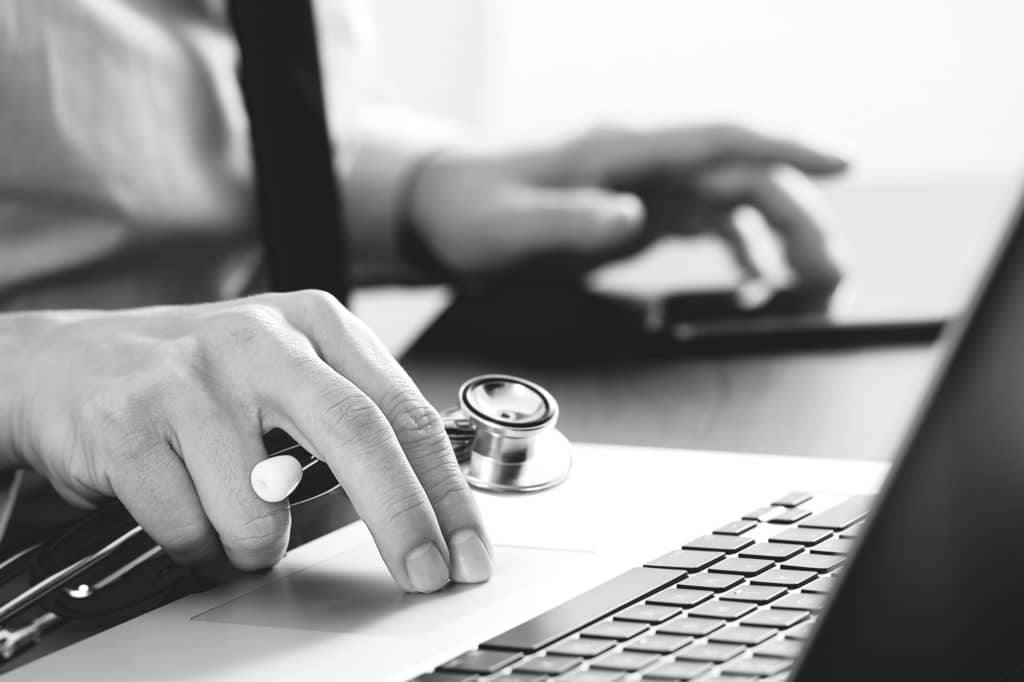
In December 2018, Susie Goodall and DHL Starlight, her Rustler 36, pitchpoled and dismasted. The boat was in 60-knot winds and massive seas some 2,000 nautical miles west of Cape Horn, Chile, during the singlehanded, nonstop, around-the-world Golden Globe Race. Goodall was thrown across the cabin and knocked unconscious.
When she came to, Goodall activated her EPIRB and made satellite-phone contact with race organizers, who called the telemedicine service Medical Support Offshore. MSOS then began monitoring her situation and providing direct medical advice until Goodall was rescued by a cargo ship.
Her story exemplifies the unvarnished reality that when maritime calamities strike, telemedicine is often the only way of getting care. Provided, of course, that one has the technology and service.
Telemedicine’s history parallels the rise of telecommunications. In 1876, Alexander Graham Bell employed his early telephone to get help after he accidentally spilled acid on his pants, and in 1879, The Lancet reported that a doctor accurately diagnosed a child during a middle-of-the-night phone call. Mariners had to wait considerably longer for real-time telemedicine capabilities, but once satellite communications evolved, the services appeared on board.
Modern telemedicine services leverage Voice-over-Internet-Protocol voice calls, videoconferencing, data compression and encryption, and (sometimes) diagnostic tools that stream real-time and stored data. Collectively, these tools have created a telemedicine ecosystem giving mariners 24/7/365 access to help.
Telemedicine comes in several forms, starting with telemedicine subscription services. These services connect mariners to an attending physician who can talk to the patient (or the captain or crew) to provide a diagnosis and treatment advice. These services typically involve a prepackaged onboard medical kit with over-the-counter and prescription drugs, sutures, and diagnostic tools. Service providers typically keep records of the kit’s contents and usually provide onshore (or online) training.
Higher-end systems include technology that gives a physician additional data-driven diagnostic capabilities. “We virtually bring the doctor to the patient as long as there’s internet connectivity,” says Michael Dunleavy, DigiGone’s founder and owner.
DigiGone’s Five Plus telemedicine kit (under $20,000) includes a built-in Wi-Fi router, as well as a custom-built 10-inch Windows quad-core tablet with a webcam and the ability to use any internet connection to run the company’s Doctor Consult app, with end-to-end encryption for all communications. Minimum connection speeds are 9 kilobits per second for device streaming and audio and 25 Kbps for video streaming; Dunleavy says ideal connection speeds are 70 to 90 Kbps.
When a user launches the Doctor Consult app, an alert goes to a physician at George Washington University’s Maritime Medical Access, or to a customer’s preferred telemedicine provider. The physician then signs into the app and can control the kit remotely. If needed, multiple doctors and specialists can view the kit’s streamed data, voice and video communications.
DigiGone’s Five Plus kit includes FDA-approved and off-the-shelf devices such as a digital blood-pressure cuff, a glucose meter, a digital thermometer, an electrocardiogram, a pulse oximeter, an electronic stethoscope, a USB macro camera, a USB otoscope and disposable headsets. These tools stream data onto the digiMed Consult dashboard, which physicians can access.
DigiGone systems use data compression to minimize bandwidth requirements, and all communications are sent and received using 256-bit advanced encryption standard technology. DigiGone users can select their image quality (from 320-by-240 to 1280-by-720) and bandwidth (up to 500 Kbps) to best match available connectivity.
Additionally, DigiGone recently partnered with RealWear, which builds rugged, wearable, hands-free Android computers. “You’re watching the doctor demonstrate how to sew up a laceration, and [the doctor] is watching you do the work,” Dunleavy says, adding that—if necessary—the doctor can call in prescriptions to a pharmacy at the yacht’s next port.
While DigiGone kits are designed to be user-friendly, users still need to complete DigiGone’s online DigiSchool training each year and pass an annual competency test.
MSOS is a medical provider to mariners and to events such as the America’s Cup, Golden Globe Race and Volvo Ocean Race. Its standard telemedicine support ($2,245 to $3,500 per year) connects mariners with a doctor-staffed, Southampton,
England-based central call center and can be scaled up to include specialist training courses and custom-made medical kits with prescription and off-the-shelf medications (MSOS has its own pharmacy). Owners with offshore itineraries can select the company’s Distant Ocean medical kit, while owners with coastal-cruising plans can select the Near Ocean medical kit.
The next level of support is the MSOS Themis TCP ($22,000) with a tablet-based telecommunications platform. “It’s a self-contained medical device with peripheral medical devices,” says Rebecca Castellano, a registered nurse who is the Americas and Caribbean sales manager for MSOS. The peripheral devices include temperature, blood-pressure, EKG, lung-function and diabetic-monitoring equipment.
“The platform allows for full case management,” she says. “Themis streams video and photos from the tablet’s front and rear cameras using the vessel’s internet connection to doctors at land-based facilities so that they can constantly monitor a patient’s vitals and offer medical advice. Support is never broken off until the patient is in medical hands shoreside or until the doctor deems the patient is in the monitoring stage.”
The Themis system leverages data compression so that its bandwidth requirements are less than 50 Kbps, and it employs medical-grade encryption. Imagery is queued for transmission, with priority given to the system’s peripheral-device data; if connectivity doesn’t exist, Themis locally stores peripheral-device data and uploads the information when connectivity resumes.
DigiGone and MSOS want clients to use their telemedicine services liberally so small issues don’t mushroom into emergencies. Clients, Dunleavy says, can “use it as a walk-in clinic” for everything from hangnails to slight coughs.
While Goodall didn’t have crewmates to help her recover from her Southern Ocean concussion, she did have a team of doctors who monitored her condition and provided peace of mind. And this, both Castellano and Dunleavy say, is a key point of telemedicine technology.









